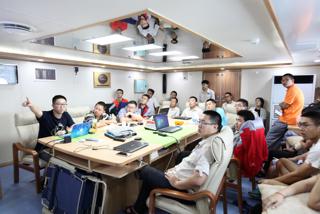Xiangyanghong 18 Finished Its Winter Voyage Mission on “Water Observation in the Southern Part of the East Indian Ocean”
On 5 February 2018, Xiangyanghong 18, China's scientific research vessel, docked at Zhoushan Port of Zhejiang province after finishing the 81-day marine investigation mission of “Water Observation in the Southern Part of the East Indian Ocean”. Being a key area to study tropical sea-air interaction, the Southern Part of East Indian Ocean has propounding influence on Chinese climate and even the whole world. As the forth segment of the Integrated Water Observation mission, this winter voyage, led by FIO and conducted by Xiangyanghong 18, aims to acquire data of marine hydrology and meteorology, marine biology, marine chemistry and ocean optics of the region by using various observing methods such as serial observation, ship-based observation, moored observation and buoy observation, thus increasing the understanding of the system structure of current and characteristics of temperature-salinity during the winter monsoon season , the features of general atmospheric circulation and the sea-air interaction process, as well as the seasonal distribution and evolution law of marine optics, microwave remote sensing parameters, marine chemistry and ecological environmental elements. Xiangyanghong 18, carrying 29 scientists and 25 crew members from FIO and National Ocean Technology Center, departed from Qingdao on 17 November 2017 and has finished the serial observation on 97 preset stations after refuelling and restocking in Indonesia and Sri Lanka for 4 times. The total sailing range is over 15,000 sea mile with a duration of 81 days. This voyage launched and retrieved 1 Bailong buoy respectively, set 2 deep-sea submerged buoys, retrieved 1 deep-sea submerged buoy and set 5 Argo drifting buoys. The multi-factor moving measurement is also completed in the mission.
This voyage marks Xiangyanghong 18’s first stop at an outer port to do replenishment and also the first time for a 1,500-ton Chinese research vessel voyaging in the deep ocean and cross equator to do long-time investigation, making Xiangyanghong 18 a new record of China as being the lightest research vessel while working for the longest time in the Indian Ocean. The voyage fulfilled the task of setting and retrieving deep-sea submerged buoys and conducted investigation on marine micro plastics for the first time in the southern part of Indian Ocean, providing essential data for follow-up scientific researches.






